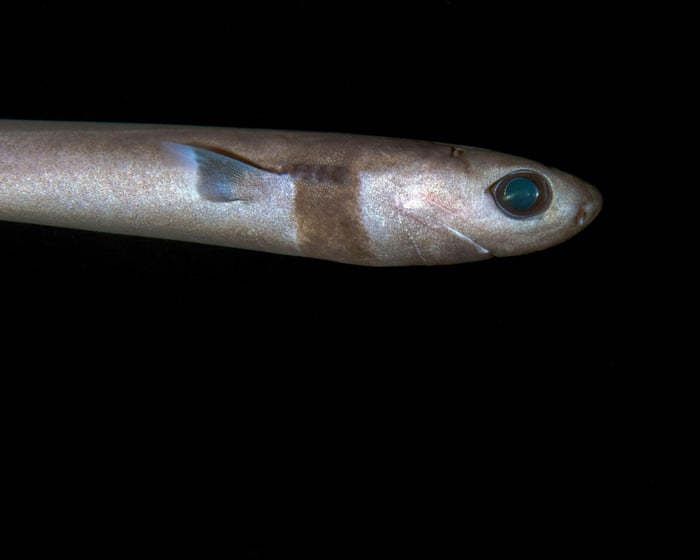Three years ago, I was leading a research project aboard a bottom trawler off the coast of Namibia, studying deep-sea sharks. These sharks live under extreme pressure near the ocean floor and are seldom seen by humans.
The sharks were caught in the trawler’s nets. By the time they reached the surface, the rapid pressure change had caused severe internal damage—a condition known as barotrauma—making it unlikely they would survive.
As a marine biologist, my role was to document the types of deep-sea sharks accidentally caught by fishers operating at depths between 200 and 450 meters.
Working with my Namibian colleague, Filippus Tshimwandi, we recorded several shark species not previously known to inhabit waters near Namibia. These included west African catsharks, which were thought to live farther up the coast, and a species of sawshark.
We also observed many gulper sharks, which have striking emerald eyes and are among the world’s most threatened shark species. They are often targeted by fisheries for their liver oil, which contains squalene—a compound used in cosmetics.
These sharks were caught because bottom trawling—even by fisheries aiming to be sustainable, like the one I worked with—involves dragging nets along the seabed, collecting everything in their path. This includes not only the intended catch but also skates, rays, and many non-target species like sharks that live close to the ocean floor. It is a highly unselective and damaging fishing method.
Some of the sharks we documented were small enough to fit in my hand, while others measured over three meters long. Many had bioluminescent spots and patches on their bodies, which may help camouflage them in the dark depths by breaking up their outline. However, since most of these animals have never been observed alive in their natural habitat, we can’t be certain.
I was fascinated by their unusual appearance and felt privileged to gather what I hope will be valuable data. These ecosystems likely play a crucial role in the ocean’s health and balance. At the same time, it was disheartening to see so many of these remarkable creatures dead.
I hope that when my data is published next year, it will raise awareness and suggest ways for deep-sea trawlers to operate more sustainably and reduce harm to these habitats.
This research has also made me realize that deep-sea mining could have a devastating impact on global biodiversity. I worry that we may be too late for many deep-sea sharks. They reproduce slowly, so if their numbers decline, recovery is difficult. We understand so little about how their ecosystems function.
If overfishing or deep-sea mining wipes out these populations, we could cause irreversible damage to deep-sea ecosystems without even realizing it.
Ruth Leeney is a teaching fellow at the University ofUniversity College Dublin’s School of Biology and Environmental Science. As told to Donna Ferguson.
This article was amended on 1 September 2025 to correct a caption that misidentified a longsnouted dogfish as a brier shark.
Frequently Asked Questions
Frequently Asked Questions About DeepSea Sharks and Their Glowing Spots
Q1 What are deepsea sharks
A Deepsea sharks are species that live in the deepest parts of the ocean often in complete darkness They have unique adaptations to survive extreme pressure cold and lack of light
Q2 Why do some deepsea sharks have glowing spots
A These glowing spots called bioluminescence are produced by special organs They help sharks attract prey communicate or camouflage themselves in the dark
Q3 How do these glowing spots work
A The spots contain lightproducing cells or bacteria that create light through chemical reactions This light can be controlled by the shark to flash or glow steadily
Q4 Can humans see these glowing spots easily
A No the glow is often very faint and only visible in the pitchblack deep ocean Special cameras or lowlight equipment are usually needed to observe them clearly
Q5 What are some examples of deepsea sharks with glowing spots
A The velvet belly lantern shark and the kitefin shark are wellknown examples They use their bioluminescence for hunting and avoiding predators
Q6 Are these sharks dangerous to humans
A Most deepsea sharks are not dangerous to humans because they live at depths where people rarely go They are generally shy and not aggressive toward humans
Q7 How do deepsea sharks survive in such extreme environments
A They have adaptations like slow metabolisms pressureresistant bodies and enhanced senses to find food and navigate
Q8 Why is it hard to study deepsea sharks
A The extreme depth darkness and pressure make it challenging and expensive to explore their habitat Special submersibles or remoteoperated vehicles are often required
Q9 Do all deepsea sharks glow
A No not all deepsea sharks are bioluminescent Its a trait found in specific species that benefit from producing light for survival
Q10 How can I learn more or see these sharks myself
A You can watch documentaries visit aquariums with deepsea exhibits or explore online resources from marine research organizations Direct observation is rare due to the depth




